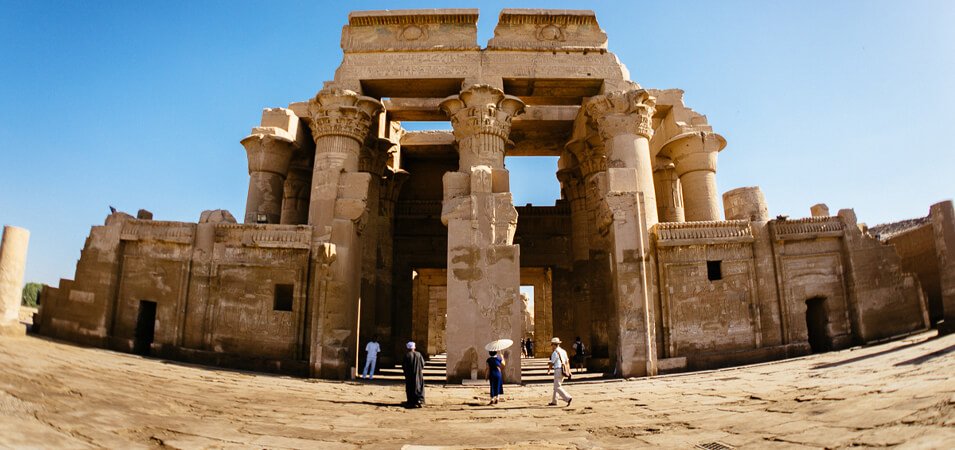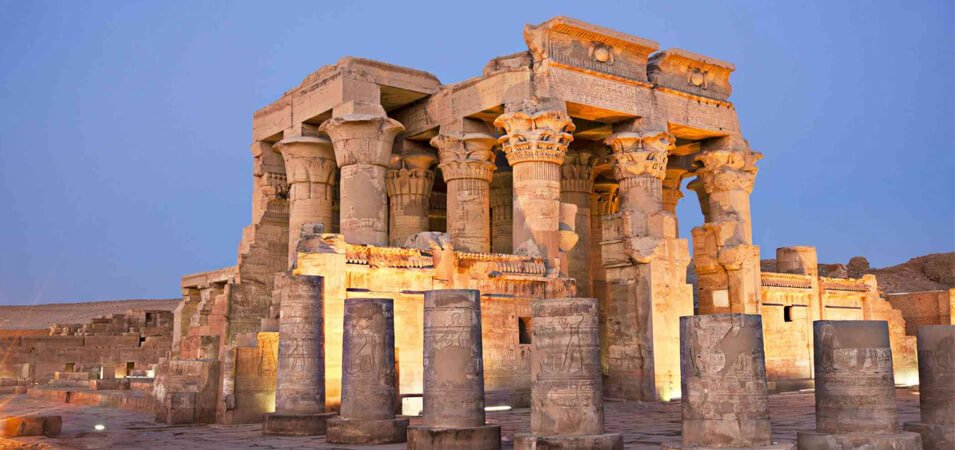Unveiling the History of Kom Ombo Temple
History buffs and students, prepare to be enthralled! The story of the Kom Ombo Temple unfolds like a captivating scroll, revealing layers of history and religious significance. Here’s a glimpse into its fascinating past:
Construction Timeline:
- Evidence suggests a temple existed on the site during the New Kingdom (around 1550 – 1069 BC).
- The grand structure we see today was built during the Ptolemaic period (305 – 30 BC).
- Construction began under Ptolemy VI Philometor (180 – 145 BC) and continued through subsequent Ptolemaic reigns.
- Ptolemy XIII Theos Philopator (51 – 47 BC) is credited with adding the impressive inner and outer hypostyle halls.
Duality and Divine Significance:
- The temple’s dedication to two deities – Haroeris and Sobek – reflects the complexity of ancient Egyptian religion.
- Haroeris (falcon-headed god): Represented kingship, the sky, and protection.
- Sobek (crocodile god): Symbolized power, fertility, and protection from Nile dangers.
- Worshipping them together signified a harmonious balance between nature’s forces and the divine realm.
Ptolemaic Legacy:
- The Ptolemies, keen to solidify their rule, revived interest in traditional Egyptian religious practices.
- Building grand temples like Kom Ombo served to link them to the gods and pharaohs of the past.
- Temple walls became a canvas for elaborate reliefs depicting rituals, offerings, and Egyptian mythology.
- These carvings offer invaluable insights into the religious beliefs and practices of the Ptolemaic era.
Unveiling the Architecture of Kom Ombo Temple
The Kom Ombo Temple stands as a testament to the ingenuity and artistry of ancient Egyptian architects. Unlike any other temple complex, it boasts a unique design that reflects its dedication to two deities: Haroeris and Sobek. Let’s embark on a journey to explore the architectural marvels that await:Double Sanctuary Layout:
The defining characteristic of Kom Ombo is its mirrored design. Two near-identical temples are fused together, with separate entrances, halls, and sanctuaries dedicated to Haroeris and Sobek. This layout embodies the harmonious balance between the two deities.Awe-Inspiring Features:
- Colossal Pylons: Towering gateways adorned with intricate carvings and hieroglyphs, these pylons act as a symbolic barrier between the human world and the sacred space within.
- Hypostyle Halls: Imagine a forest of towering columns with floral capitals, their shadows dancing on the floor. Light filtering through an astronomically decorated roof creates a captivating atmosphere.
- Inner Sanctuaries: Each dedicated sanctuary houses intricate reliefs depicting rituals and offerings made to the respective deity – Haroeris or Sobek.
- Hieroglyphs: These fascinating symbols adorning the temple walls serve as a window into the beliefs and practices of ancient Egyptians.
Beyond the Obvious:
The Nilometer: This ingenious invention built into the temple walls measured the Nile’s flood levels, crucial for agricultural success in Egypt.The Significance of Kom Ombo Temple Today
The Kom Ombo Temple transcends its role as a magnificent structure; it serves as a vital key to unlocking the mysteries of ancient Egypt. Here’s why the temple remains significant today:- Understanding Ancient Beliefs: The temple’s dedication to two deities and its intricate carvings offer invaluable insights into the complex and fascinating world of ancient Egyptian religion. Studying the temple allows us to understand the roles of Haroeris and Sobek, the rituals practiced, and the beliefs held dear by the civilization.
- Architectural Marvel: The Kom Ombo Temple stands as a testament to the architectural prowess of the ancient Egyptians. Its unique double sanctuary layout, colossal pylons, and awe-inspiring hypostyle halls provide valuable information about construction techniques and artistic styles of the Ptolemaic period. Studying the temple helps us appreciate the ingenuity and skill of these bygone artisans.
- Preserving the Past: The ongoing restoration efforts at Kom Ombo Temple are crucial for ensuring this priceless heritage site endures for generations to come. These efforts involve stabilizing damaged structures, cleaning and conserving carvings, and mitigating the effects of time and weather. By preserving the temple, we safeguard a vital link to our past and ensure future generations can experience its wonders.
- Cultural Significance: The Kom Ombo Temple holds a special place in modern Egyptian culture. It serves as a symbol of the country’s rich history and a reminder of the pharaohs who once ruled these lands. The temple also attracts tourists, generating revenue and contributing to the local economy
Your Guide to Visiting Kom Ombo Temple
Calling all adventurous spirits! The magic of Kom Ombo Temple awaits, and here’s your ultimate guide to planning your visit: Embarking on Your Journey:
Embarking on Your Journey:
- From Cairo: Buckle up for a scenic journey south. You can choose between a comfortable train ride (approximately 12 hours) or a private car transfer (approximately 10 hours). Opting for a guided tour from Cairo allows you to relax and enjoy the historical insights provided by your guide.
- From Luxor: Travelers in Luxor are in for a treat! The distance is significantly shorter, with public buses and taxis readily available (approximately 3-4 hour journey). Consider joining a day trip from Luxor that combines visits to both Kom Ombo and Edfu Temple, maximizing your exploration time.
Planning Essentials:
- Weather Wise: Egypt’s scorching summers can be daunting. Aim for the shoulder seasons (spring and autumn) when temperatures are pleasant (around 25-30°C). Winter offers cooler weather but fewer daylight hours.
- Tickets: Purchase tickets at the temple entrance. Consider carrying local currency (Egyptian Pounds) for ease of transaction.
- Dress Code: Opt for loose, lightweight clothing that covers your shoulders and knees. Respectful attire is recommended when visiting religious sites.
- Sun Protection: Egypt’s sun is powerful. Pack a hat, sunglasses, and sunscreen to ensure a comfortable visit.
